Building a custom food delivery app is a great way to expand business for both individual restaurants and restaurant chains. Some entrepreneurs also benefit from adding their restaurants to aggregator apps, which serve as intermediaries between eateries and customers.
However, developing a food ordering and delivery solution can be challenging. Behind a user-friendly app lies a complex back end that powers every order, tracks every delivery, and manages communication between restaurants, couriers, and customers. You need a professional development team to ensure a reliable back end that includes personalized features and a solid architecture.
This article dives into the backend development process. We guide you through crucial steps like choosing the right framework, setting up the server, and creating a user-friendly food delivery admin panel. As a bonus, you’ll learn about leveraging modern technologies like artificial intelligence (AI) for smarter recommendations and the blockchain for enhanced security.
Whether you’re starting an IT project for an individual restaurant or planning to create a full-scale food delivery application for a restaurant chain, this article will help you grasp crucial insights about setting up your app’s back end.
Two main types of food delivery applications
The food delivery industry has witnessed a remarkable transformation in recent years, spurred by technological advancements and changing consumer preferences. All food delivery apps are based on one of two models:
Order and delivery model. These apps are owned and operated by individual restaurants or chains. Restaurant apps enable customers to order food directly from a specific restaurant and have it delivered to their doorstep. By developing a restaurant app, establishments can enhance their brand visibility, engage with customers more effectively, and generate additional revenue streams. However, managing delivery logistics becomes the responsibility of the restaurant, necessitating the hiring of delivery personnel and the implementation of efficient delivery processes. Order and delivery apps offer a personalized experience, allowing customers to explore a restaurant’s full menu, customize their orders, and track delivery statuses in real time. Moreover, restaurants can help drive customer retention and satisfaction by integrating features such as:
- Loyalty programs
- Customer reviews
- In-app promotions
Aggregator model. These apps serve as intermediaries between customers and multiple restaurants. Aggregator platforms work with various eateries, presenting users with a wide range of dining options to choose from. Customers can browse menus, place orders, and make payments within a single app interface. Unlike restaurant-owned apps, aggregators take responsibility for coordinating deliveries, acting as a conduit between restaurants and customers. The aggregator model offers convenience and variety, catering to customers’ culinary preferences and facilitating hassle-free ordering experiences.
When you choose to build a food delivery application, you will need to develop a separate version for each type of user (couriers, restaurants, administrators, or end users). Aggregator apps might need an additional version, especially if they deal with couriers and restaurants separately. Let’s take a closer look at these app versions.
Need a scalable back end for your application?
Leverage our expertise to take your business to the next level. Let our developers build you a secure and reliable application.
Ecosystem of food delivery applications
When you plan to develop a restaurant food delivery app, you’ll need three versions of it: for customers, for couriers, and for administrators. For an aggregator app, you might need to create an additional optional restaurant partner version. Some aggregator platforms offer restaurants a dedicated app to manage orders, receive updates, and potentially update menus and availability. However, this functionality might be integrated into the admin panel for food delivery app.
Each app serves a specific purpose within the delivery ecosystem and requires tailored features to optimize functionality and the user experience. While they may have separate interfaces and functionality to cater to the specific needs of customers, couriers, and administrators, each is part of the same software system. Let’s briefly look at the features in each of these apps to better understand how your back end should work.
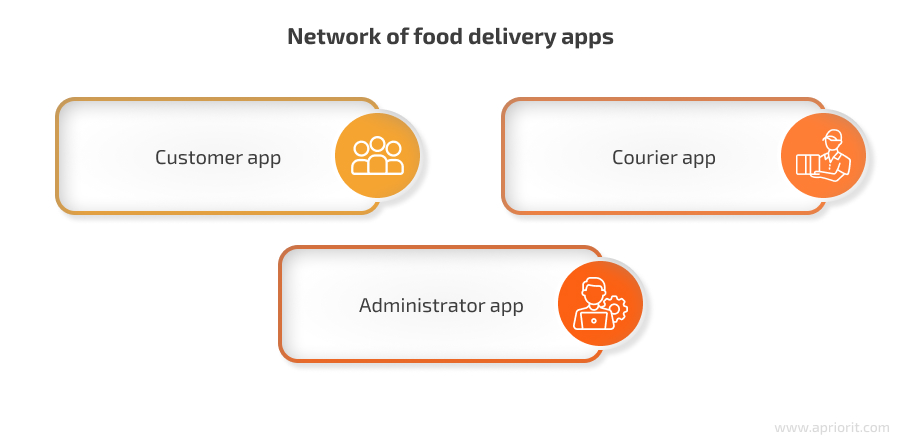
Customer app. The customer application is your main product. Usually a mobile app, it serves as the primary interface for users to browse menus, select food and drinks, and specify delivery details such as time and location. The app might also show special offers and other services offered by the platform. The customer app should allow users to easily pay for their orders, see their order statuses, and perhaps even track couriers in real time.
Here are the main features of a customer app:
- User profiles
- Menu navigation with search and filter options
- Estimated delivery times
- Real-time order tracking
- Secure payment gateway
- Ratings and reviews
- Push notifications
Courier app. The courier app plays a critical role in facilitating efficient deliveries. Usually, it’s a mobile app that sends timely notifications to couriers regarding new orders and assigns the orders appropriately. A courier’s profile should provide a clear view of current orders, including details and a countdown timer to emphasize urgency. For optimized delivery times, the app should automatically generate a route to the delivery address and display it on a map as soon as an order is accepted.
The main features of a courier app are:
- Personal courier profiles
- Map with routing functionality
- Order management tools
- Order status updates
Administrator app. This app is meant for a restaurant that prepares and delivers food to customers. It’s usually a web application, as it’s more convenient to see all orders and manage couriers from a desktop computer. This interface allows for centralized oversight of all orders, streamlines courier management, and provides a platform for managing specific business needs. The functionality of this app will vary depending on a restaurant’s unique business requirements. Here are the most crucial features:
- Individual administrator accounts ensure that only authorized personnel can access the food app admin panel to manage the delivery service. If your business model requires administrators with different roles, you can assign those roles to different accounts.
- Content management allows administrators to edit restaurant information, menus, and prices.
- Discount functionality allows for setting up promotional offers and discounts and automatically changing prices.
- User management provides tools for reviewing user data, including order history and preferences, to make the service more personal or to manage potential order issues.
- Courier performance tracking features allow administrators to monitor courier activity and performance metrics, such as the number of successful deliveries, average delivery time, time of employment, and so on.
- Order processing includes tracking order statuses, routing orders to restaurants, and potentially sending notifications – functions essential for managing the order fulfillment process.
- Push notifications are a communication channel that allows for sending app updates, promotions, and order status updates to users.
- Analytics functionality provides administrators with insights into user behavior, order trends, and revenue streams — all critical data for business decisions and performance evaluation. It can also show you how well your app performs from a technical standpoint.
- Payment processors can be connected to your dashboard with the help of third-party APIs. This feature can let you see all incoming payments for all orders and manage your revenue flow.
It might not be enough to simply implement some features without understanding how to build a complex and balanced system for a successful food delivery app with backend. Let’s see how you can build a robust backend that seamlessly connects all parties involved in the food delivery process.
Read also
API Management Essentials: Strategies and Tools
Gain valuable insights into the significance of API management and learn about key strategies for effectively auditing, maintaining, and updating APIs. The article explores essential API management tools and platforms, helping you to make an informed decision about API management.

How to set up the backend for a food delivery app
While users interact with your service through iOS/Android mobile apps and your website, these apps rely on backend processes to function. The backend of your food delivery app serves as the backbone of your entire operation. It handles all crucial business processes, stores user and restaurant data, and ultimately powers all user-facing web and mobile functionality.
Here’s a breakdown of the key steps involved in setting up your food delivery app backend:
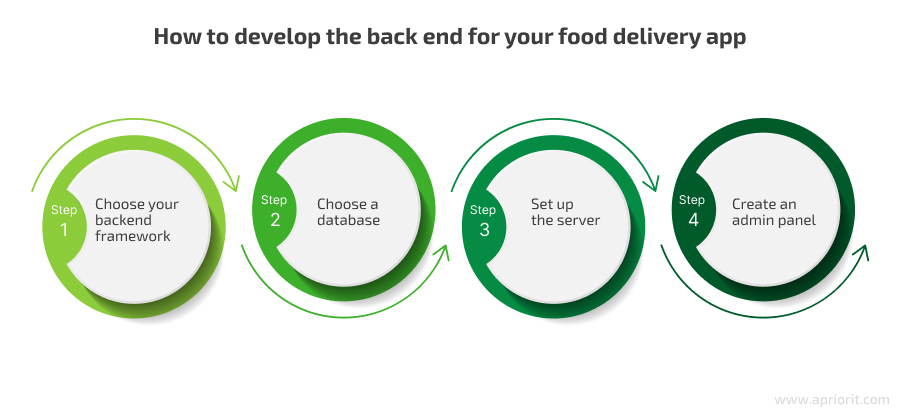
Step 1: Choose your backend framework
A framework processes user requests, manages business logic, and connects with various components of your application. Frameworks are essentially large sets of libraries that make it easy to integrate:
- Payment processors
- Mobile-specific functionality
- Third-party services
- Admin panels
- Sorting logic
- Business logic
Each programming language usually has several frameworks to choose from. Here are the best frameworks for the three most suitable languages for developing the back end of a food delivery app:
PHP. Symfony and Laravel both offer extensive libraries and pre-built solutions for efficient development. The choice between these PHP frameworks comes down to personal preference, as both have lots of libraries and out-of-the-box solutions. You can use either framework for small and large projects, so no matter what you want — a simple MVP to show your investors or a full-fledged online delivery service — Symfony and Laravel can handle it.
Python. Django and Flask both work well for food delivery software. However, Django has a significant advantage: its own default admin panel. This means your developers won’t need to install a third-party library to get you an admin panel, making Django a faster way to create an admin panel for your business.
JavaScript. While traditionally used for frontend development, JavaScript frameworks like Express.js and NestJS are gaining traction for backend development due to their scalability and asynchronous processing capabilities. Express.js offers a lightweight and flexible approach, while NestJS provides a more structured and scalable architecture suited for complex applications.
While JavaScript frameworks are becoming increasingly popular for backend development, PHP and Python frameworks remain dominant choices due to their maturity and extensive libraries specifically designed for backend tasks. The choice of framework ultimately depends on your project’s specific needs, team expertise, and desired development approach.
Step 2: Choose a database
Choosing the appropriate database is a critical decision in building the food delivery app backend infrastructure. A database stores and organizes your data, from customer profiles and order information to restaurant details and menu items. It’s important to choose a database that aligns with your application’s scalability, performance, and data management requirements. Here are some recommended options from Apriorit experts:
MongoDB is a database with a document-based structure that can process data extremely fast. It’s great for applications that require dynamic data processing, such as for order statuses and real-time updates.
PostgreSQL is an advanced database with many features for accomplishing tasks like advanced menu management, delivery route optimization, and personalized customer recommendations. This database is excessive for a small MVP, but it’s a good choice for a large-scale food delivery solution that needs robust data integrity and sophisticated data modeling.
MySQL takes the best of both worlds: it offers a productive balance between functionality and ease of use, making it a strong choice for various food delivery app needs.
There are also two caching tools – Memcached and Redis – that will help you reduce the number of requests to the server and optimize your app’s work.
Read also
Data Management Based on SQL Server: On-Premises vs Cloud Database
Learn more about factors influencing the choice between on-premises and cloud-based SQL Server deployments. We compare parameters such as cost-efficiency, security, flexibility, and data control, allowing you to choose the best data management infrastructure for your needs. support for existing features.
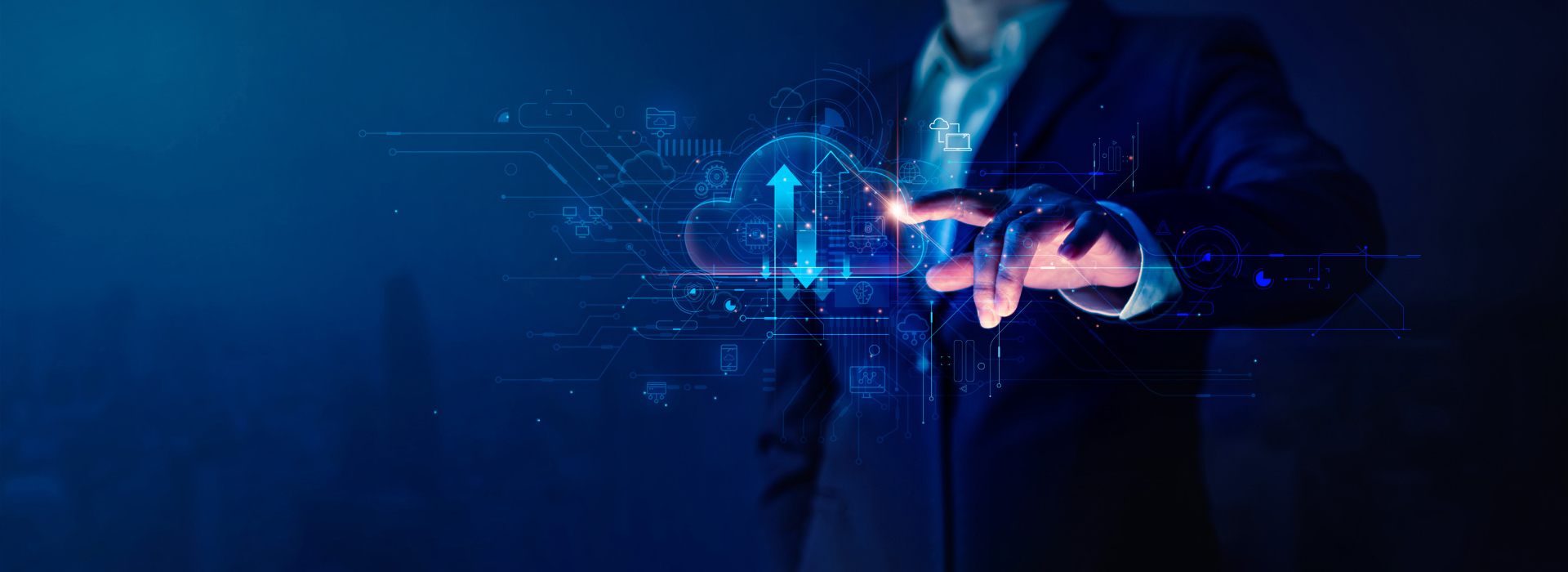
Step 3: Set up the server
To store all your data, you’ll need a server. Your server infrastructure forms the backbone of your food delivery app’s backend architecture. The server is the central hub for storing and processing data, handling incoming user requests, and ensuring seamless communication between various app components. Choosing the right server infrastructure is crucial for storing and managing app data. You can choose between these two options:
- A dedicated server is a physical server you rent. This is a great choice for complex calculations and high-performance needs. You will get exclusive access to physical hardware and unparalleled control, security, and performance as a result. On the other hand, dedicated servers lack mobility and require careful maintenance and management to ensure optimal functionality.
- A cloud server is a virtual server that offers a flexible and scalable alternative to traditional dedicated servers. With a cloud server, you can easily move your data if you decide to scale your business or adjust resources according to fluctuating demand. You can also rapidly expand your storage capacity.
For food ordering and delivery companies, cloud servers might be better, as they are flexible and easy to maintain. Сonsider factors such as reliability, scalability, security features, and pricing models before making your decision. Our specialists can recommend leading cloud service providers such as:
All of these offer a range of services tailored to meet the needs of food delivery businesses.
Once you’ve chosen your server type and cloud service provider, you’ll need to configure a web server to handle incoming requests from users’ devices (mobile apps, web browsers). Two of the most commonly used web servers are Apache HTTP Server and Nginx. These servers act as intermediaries, receiving user requests, interpreting them, and fetching the necessary data or resources from your backend application. They then send the requested information back to the user’s device.
Step 4: Create an admin panel
A food delivery admin panel provides a management interface for your backend. This is where you’ll manage restaurants, users, orders, and other aspects of your food delivery service. While not essential, an admin panel streamlines administrative tasks and offers greater control over your platform. There are two frameworks that our experts recommend:
Symfony frameworks. Popular tools include:
- Easy Admin. This is a fast and user-friendly option known for its ease of development and rich set of features. It allows you to quickly generate admin interfaces for your backend without writing a lot of code.
- API Platform Admin. This tool leverages Symfony’s built-in API Platform to automatically generate an admin panel based on your application’s API definitions. It’s a good choice if you already have a well-defined API for your back end.
- Sonata Admin. This is a mature and feature-rich admin bundle for Symfony. It offers a wide range of customization options and functionality, but it may have a steeper learning curve compared to Easy Admin.
Django framework. Django has a built-in admin panel, which means that you don’t need any additional tools. It allows you to manage your application’s data and users directly, saving development time and resources. The Django admin panel is also customizable, allowing you to tailor it to your specific needs.
The best choice for your admin panel depends on your project’s requirements and your development team’s preferences. If you prioritize fast development and ease of use, Easy Admin for Symfony or the built-in Django admin panel might be ideal. For more complex needs and extensive customization options, you might consider Sonata Admin for Symfony.
Using modern technologies to develop your app can offer exciting opportunities to improve the user experience and streamline operations. Advanced technologies like AI and the blockchain can help build trust with your users, increasing the transparency of payment and delivery processes. Let’s see how you can leverage these technologies in your food delivery application.
Read also
How to Create a Blog with Django for Your Python Web Application
Explore how to leverage Django’s capabilities to build a robust and feature-rich blog. In this article, we share steps for creating a blog using Django and Python, which can help with sharing engaging content, attracting customers, and increasing brand visibility.

Introducing AI and blockchain to food delivery apps
From providing intelligent recommendations to streamlining the ordering process, AI offers lots of benefits for both users and businesses. Let’s explore why you should integrate AI into your food delivery app, specifically via smart chatbots:
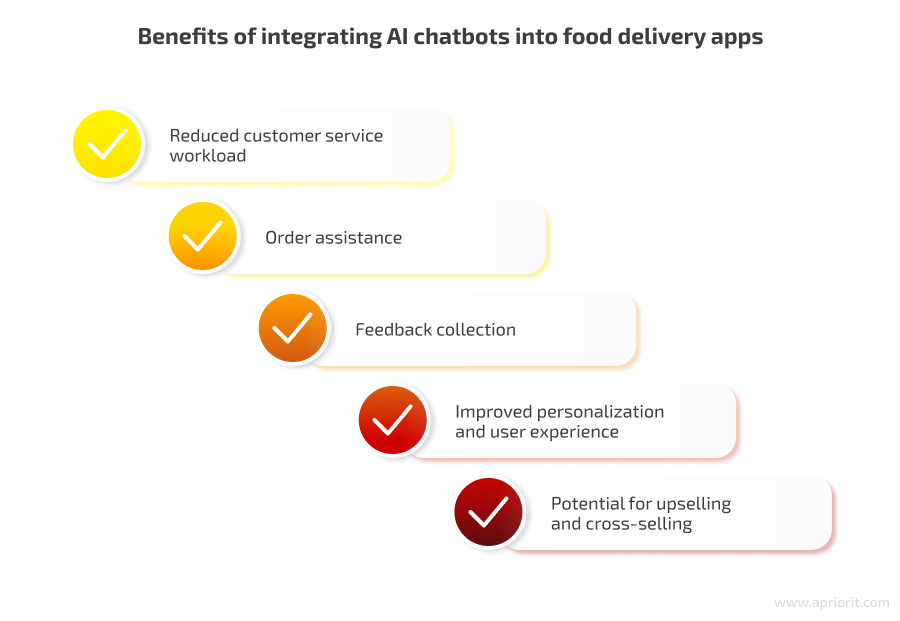
- Reduced customer service workload. AI chatbots enable round-the-clock customer support, allowing users to seek assistance at any time of the day. Whether tracking an order, resolving an issue, or providing information about promotions, chatbots ensure prompt and efficient service.
- Order assistance. Chatbots can guide users through the ordering process, offering suggestions, answering queries, and assisting with order customization. This real-time support improves order accuracy and reduces the likelihood of errors or misunderstandings.
- Feedback collection. A chatbot can ask customers for feedback after delivery, allowing restaurants and aggregators to gather valuable insights and improve service quality. By analyzing feedback trends, businesses can identify areas for enhancement and tailor their offerings to meet customer expectations.
- Improved personalization and user experience. AI-powered chatbots can analyze user preferences, order history, and browsing behavior to provide personalized food recommendations. By understanding individual tastes and dietary restrictions, chatbots can suggest relevant menu items, enhancing the overall customer experience.
- Potential for upselling and cross-selling. Through targeted recommendations based on user preferences and past behavior, AI chatbots can generate upselling and cross-selling opportunities. By suggesting complementary items or promotional deals during the ordering process, restaurants can increase average order value and drive additional revenue.
Blockchains, known for their secure and decentralized ledger systems, offer a unique set of advantages for the food delivery industry. Given their tamper-proof nature, blockchains can revolutionize the way we track orders and ensure transparency throughout the delivery process. Here is what you can get from introducing a blockchain into your food delivery project:
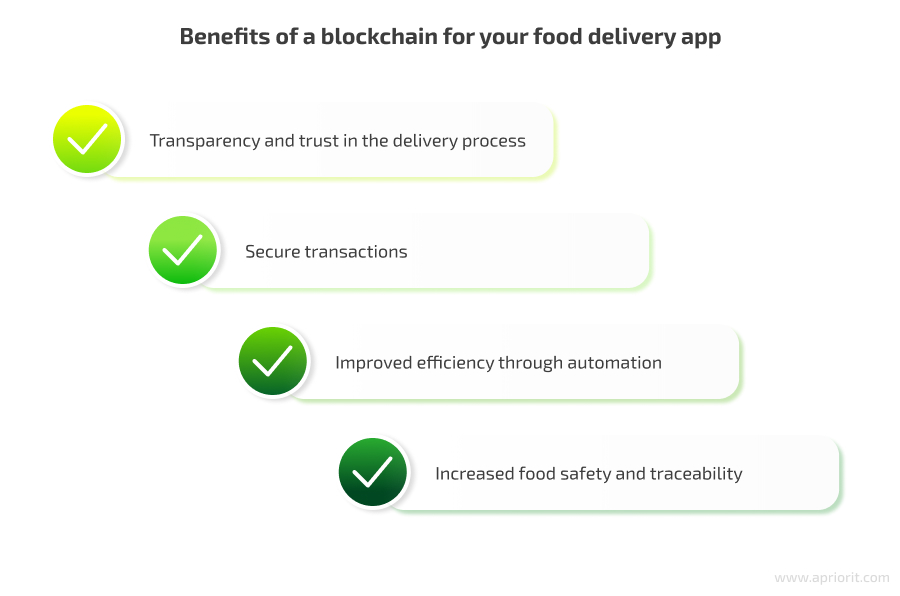
- Transparency and trust in the delivery process. A blockchain creates an unalterable record of every step in the delivery journey, from order placement to receipt by the customer. This fosters trust between all parties: restaurants, delivery personnel, and customers. Everyone can see exactly when an order was placed, prepared, picked up, and delivered, eliminating discrepancies or room for manipulation.
- Secure transactions. Blockchain technology facilitates secure and tamper-proof transactions within the food delivery ecosystem. By recording order details, payment information, and delivery statuses on a decentralized ledger, a blockchain ensures data integrity and minimizes the risk of fraud or unauthorized access. Smart contracts automate and enforce the terms of agreements between parties involved in the delivery process.
- Improved efficiency through automation. You can use a blockchain to automate various aspects of logistics management, such as assigning deliveries to drivers based on location and availability. This reduces manual intervention and optimizes delivery routes, leading to faster deliveries and improved operational efficiency for restaurants and delivery companies.
- Increased food safety and traceability. A blockchain can track the origin of ingredients throughout the food supply chain, providing valuable insights into food provenance. This allows restaurants to ensure the quality and safety of their ingredients while giving health-conscious consumers greater transparency about where their food comes from. In the event of a food recall, a blockchain can efficiently trace the movement of contaminated ingredients.
Ensuring timely and efficient order delivery presents a challenge for food delivery businesses, and especially for aggregator apps. To mitigate this risk, some companies partner with third-party delivery services or implement innovative solutions such as AI-powered chatbots and blockchain technology for enhanced delivery tracking and transparency. Our Apriorit professionals have extensive experience in both AI and the blockchain, so we can work together to deliver a perfect solution to your problem.
Related project
Building AI Text Processing Modules for a Content Management Platform
Discover the possibilities of enhancing your platform with AI-powered text processing capabilities. We implemented three AI modules to translate, generate, and format text, resulting in improved content management efficiency and a competitive edge in the market.

How can Apriorit help you in developing your food delivery app?
Integrating AI and blockchain technology into your food app admin panel holds great potential. You can make your app more competitive, enhance food safety, and create a more secure delivery ecosystem. Looking to build a food delivery app that’s efficient, scalable, and delivers a seamless user experience? Apriorit’s team of seasoned developers can be your trusted partner in crafting the powerful engine that drives your app.
Our experts will create a roadmap for you, including initial research and discovery, design, and frontend development. We also specialize in building robust and secure backend solutions tailored to each project’s specific needs.
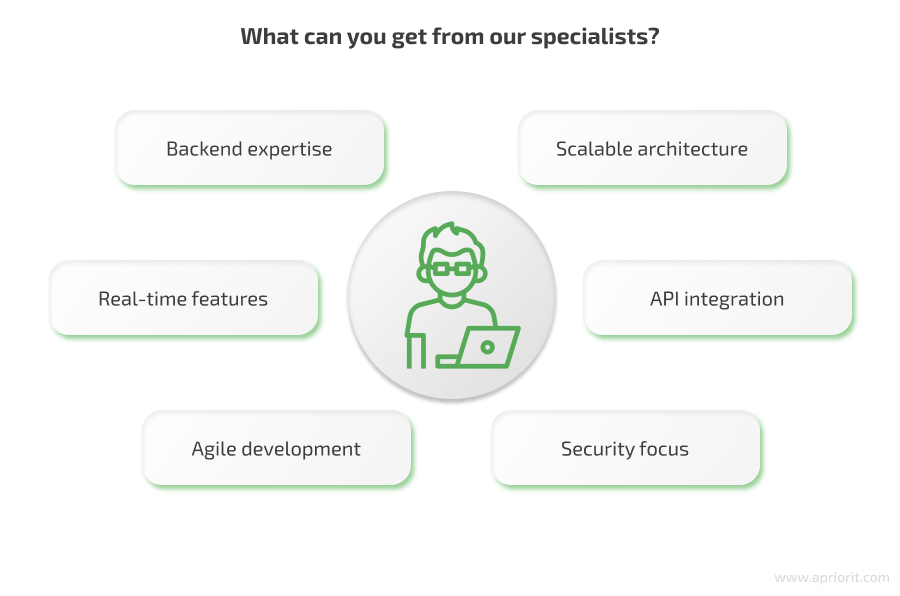
- Backend expertise. Leverage our 20+ years of experience to make sure your product is built using the most fitting frameworks and tools. Our specialists will create a high-performance back end that can handle real-time processing, manage large data volumes, and seamlessly integrate with various third-party services.
- Scalable architecture. Our backend architecture is designed to seamlessly scale alongside your growing user base and order volume. As your business expands, your back end can seamlessly scale to accommodate increased traffic and data demands.
- Real-time features. Leverage real-time features like live order tracking, instant notifications, and dynamic updates. Powered by modern backend frameworks, these features will keep customers informed and streamline operations for both restaurants and couriers.
- API Integration. Ensure smooth communication between your back end and various third-party services like payment gateways, mapping APIs, and restaurant management systems. Apriorit has extensive experience in API integration, ensuring seamless communication between your app and external tools for smooth operation.
- Security focus. We prioritize robust security measures throughout development. Our cybersecurity specialists implement industry-standard security practices and stay up to date on the latest threats to safeguard your app.
- Agile development. We use an agile development approach that promotes collaboration and clear communication. In this way, we ensure that your specific needs and vision are translated into a back end that perfectly aligns with your food delivery app’s goals.
By partnering with Apriorit, you gain access to a team of talented developers who can create a secure, scalable, and efficient back end for your food delivery app. Together, we can build a platform that empowers users, restaurants, and couriers alike, driving success for your food delivery business.
Conclusion
Delivering a flawless frontend is crucial for a perfect user experience. But prior to working on it, your team should focus on the app’s back end, as it’s the core of your food delivery software ecosystem. It’s the back end that handles critical functions such as data storage, processing, and management.
From managing user profiles and order information to facilitating real-time communication between customers, couriers, and restaurants, a well-designed back end creates a seamless and efficient food delivery experience. To ensure a great experience for your customers, entrust your app development project to true professionals.
At Apriorit, we can develop a robust backend for your application. Our experts not only ensure the smooth functioning of your app but also lay the groundwork for future growth and innovation. With a well-designed back end, you will be able to adapt to changing market demands, seamlessly scale your operations, and deliver exceptional service to your customers.
Don’t compromise on your application’s security
Our experienced developers craft secure and scalable solutions that deliver real results for your business. Let’s start working on your project today!




